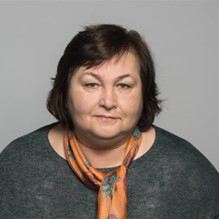Biocheminių Tyrimų Laboratorija
- Home
- /
- Scientific Research Laboratories
- /
- Biocheminių Tyrimų Laboratorija
Mokslinių tyrimų kryptis
Laboratorijos vadovė
- Ląstelių membranų barjerinės savybės ir molekulinė bioenergetika. Ši kryptis aktuali biomedicinai, nes tyrimais siekiama padidinti infekcinių ligų gydymo efektyvumą. Ieškoma bakterijų, mielių ir mikroskopinių grybų sąveikos su biocidiniais junginiais ir virusais, ieškoma būdų, kaip padidinti gerai žinomų antimikrobinių junginių efektyvumą, stiprinant jų sąveiką su mikroorganizmais. Tiriami naujai susintetinti junginiai, sukeliantys stresą mikroorganizmams. Ieškoma naujų būdų, kaip (1) padidinti mikrobų apvalkalų pralaidumą ir (2) slopinti išstūmimo siurblių aktyvumą. Taip pat kuriami nauji metodai, skirti greitam mikroorganizmų gyvybingumo nustatymui, lazerinio taškinio kontrasto metodu tiriamas bioplėvelę formuojančių mikroorganizmų atsakas į antibiotikus ir fungicidus, analizuojamos metaboliškai aktyvių ląstelių plazminės membranos barjero lipofiliniams anijonams priežastys ir mechanizmai.
- Augalų biochemija, orientuota į augalų streso atsako taikomąjį potencialą. Ši kryptis susijusi su novatoriškų, pažangių ir tvarių žemės ūkio metodų, pagrįstų augalų plastiškumo, adaptacijos ir streso atsako molekulinių mechanizmų žiniomis, kūrimu. Bendradarbiaujant su tarptautinio plazminės žemdirbystės tinklo https://plagri.eu/ nariais, tyrime bus tiriami augalų reakcijos į sėklų apdorojimą fiziniais stresoriais, tokiais kaip žemos temperatūros plazma (šaltoji plazma, CP), vakuumas arba elektromagnetinis laukas (EML), molekuliniai mechanizmai. Tikimasi, kad gautos žinios bus panaudotos kuriant augalų produktyvumo, atsparumo stresui ir antrinio metabolinio aktyvumo skatinimo metodus, ypatingą dėmesį skiriant farmakologiškai svarbių vaistinių medžiagų biogamybai. Bus atliekami eksperimentai laboratorijoje, šiltnamyje ir lauke, tiriant skirtingus sėklų apdorojimo plazma aktyvuotu vandeniu (PAW) derinius, tiriant fizinių sėklų stresorių ir PAW taikymą aeroponiniam ir vertikaliam augalų auginimui. Bendradarbiaujant su pramonės partneriais, tikslas – sukurti apdorojimo sistemas, kurias būtų galima pritaikyti naudoti namuose ir šiltnamiuose, rengiant protokolus, prototipus ir gaires, kaip šias sistemas naudoti ūkiuose ir pramonėje.
